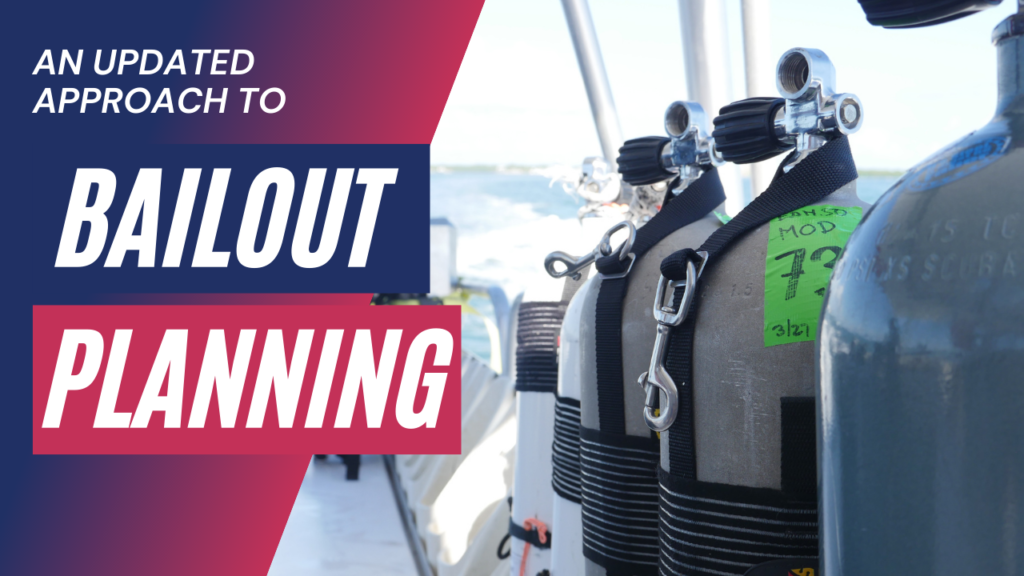This is a step-by-step process that takes you through ‘old school’ to ‘new school’ approaches and offers an alternative.
The Basic Info
For the purposes of planning on any method, we need a few basics. These are:
- SAC (Surface Air Consumption Rate) – TDI standards for a bottom bailout (45lpm) and deco bailout (30 lpm)
- Volumes and anticipated cylinder fill pressures
- A decision on gas choices
- Maximum depth for the dive
- Known personal limits (thermal, hydration, fitness, psychological, etc)
- Site specifics that will modify the plan (current/penetration etc)
- Ascent/descent rates
Deco/Bailout Gas Choices
I like to select optimum deco/bailout gases that do not have too big a depth gap in them. So, for a 50m dive, a 21m or 50% deco gas is only ever 29m away. In an emergency, we can go up to this fairly quickly. Even at “normal” ascent rates, it’s 3 minutes away. This is the biggest gap I like. Then, it’s balancing carrying a second gas against time saved on deco. 100% is always useful for offboarding.
Then I like to bailout to a PO2 of 1.6 to maximise the deco / O2 window. Understand that if I bailout, I am taking the express elevator to the surface, so PO2 will drop off fast anyway.
Deco Gas Reserves. Bailout – you generally need all of it or none of it. The realistic odds of having a second CCR failure of a teammate and the teammate or you losing their bailout gas as well is in the realms of ‘BS people on Facebook make up’. So, 20 bar for gauge error, the rest is yours.
Team Bailout
A word on team bailout – less than 100m diving – don’t do it. Sub 100m it’s not a team as such, but safety divers staged bailout that will help – here’s why.
You will bail out and ascend urgently in one of two scenarios
- Hypercapnia (CO2 breakthrough) in which case you will be narked (CO2 is narcotic), panting like a steam train and chuffing through your bailout at speed. You will not stop to look at or signal a teammate, nor is it likely they can catch up to you in your off shot line ascent as you get as shallow as your deco will allow as fast as possible. In clear blue waters, maybe you and the other diver might find each other again. In typical northern European or East Coast USA diving, 10m separation is lost to everyone else.
- Full flood. The bonus of this is you will be stress breathing, but not CO2 hit level breathing, so you may get back to the line with teammates or staged gas. Are you willing to gamble on that? As above, 10m vertical or horizontal separation is usually permanent separation as you will have lost sight completely.
First Steps for all methods
- Calculate available bailout gas
- Calculate your gas requirements for bailout ascent (including deco times)
- Compare these gas requirements against available gas
- Two choices
- Reduce bottom time within gas limits or
- Carry (stage if guaranteed access) extra gas
- Two choices
- Using tables or dive planning software, plan a bailout ascent within gas restraints and identify the maximum bailout time you can get out of that gas.
- Decide on “other factors” and known personal limits what the maximum tolerable ascent time can be in the event of the bailout, this may reduce the time
Old School
- Take the max bottom time and deco time from above and put on your wet notes, making sure you have enough scrubber duration and onboard gas supply, with reserves.
- You thumb the dive (leave depth) at this bottom time.
- In Open circuit, we re-run the numbers twice
- Assuming a 3-minute delay
- Assuming you violate depth by an extra 3 metres
There is no value to this in CCR, as we have extra gas and scrubber duration and we don’t assume a full bailout AND depth or time violations on the same dive.
- Note the bailout schedule on your wet notes
- In the event of a bailout – pull this schedule out and follow home
So now we have our old school plan and can dive this on no more than a bottom timer if on manual CCR or our handset dies.
It’s a great exercise all my students do, especially the discipline of sticking to the runtime.
New School!
Now, computers give us more flexibility. When we are exploring a wreck or reef, it is very unlikely we will be at full depth the whole dive, so the tables above penalise our bottom time based on a known decompression/bailout time and gas limit. What we need to know is two critical bits of information
- What maximum time to surface (TTS) can we manage on the available bailout gas, including reserve/gauge error allowance (I use 20 bar per cylinder)
- What is our scrubber and onboard gas duration limit(s)
Onboard CCR gas limit is easy as long as we have full cylinders and are competent at minimum loop, as it should exceed scrubber duration (if you are using radial scrubbers and need to read this, perhaps you should talk privately to me).
Max TTS (time to surface) is possible to do by calculating required bailout ascent/deco time (using whatever conservatism – or not – you like for bailout) and bailout gas for those stops and ascent time based on TDI’s recommended 45lpm and 30 lpm sac rates.
Dive planning software and even the functions on many modern dive computers allow these parameters to be recalculated many times faster than manually and probably more accurately. Just keep adjusting the bottom time at your max depth until you reach your bailout gas capacity limits.
Then, note the total runtime less the bottom time used in the plan. This is your max TTS.
Once you know max TTS, you can dive happily and ascend once any one of TTS, Scrubber, onboard gas, CNS/OTU limits is reached, thus maximising underwater time.
Happy days. Except it’s a lot of gas, especially deco gas.
Alternative Approach
Your worst-case scenario for a bailout is a CO2 hit, mainly because your sac rate will be through the roof. TDI standards are 45lpm and this is a bottom-line minimum. TDI reduces these to 30 litres a minute on deco, yet a CO2 hit takes as a minimum of 15 minutes to recover from in healthy navy divers1 and 10-15 minutes in Warkander & Shykoff’s (2015) study (although while respiration was down, cognitive functions were not restored for some hours!)
Let’s double that up to 30 minutes – seems fair for us mere mortals. You will probably be well north of 30 min while on stops as ceilings are pretty much guaranteed to start before the 30 mins is up (individuals sac rates can and will vary but variations upwards from 45 lpm are a much safer bet and substantially more likely than down.)
How can we plan for this? Well, an alternate is to plan for 30 minutes of breathable gas at any depth of the dive at 45 lpm + (maybe 60 min?), and the rest of the gas needs at a more normal sac rate (minimum of 30 lpm).
This higher gas volume can then be bottom gas and maybe a possible combination of bottom and intermediate gas for very deep dives. The joy of this being high volume and maybe multi-cylinder is that it will also be high helium content, so neutral or floaty and easy to have on a leash with little effort to haul around once in the water.
What if you have to bail on deco I hear… well good news in many ways
- You will already be significantly shallower
- Your bottom gas is probably breathable, and your intermediate gas is definitely breathable at all stops except maybe 6m or 9m for very deep dives.
- The impact on switching to intermediate or bottom gas even if already on stops will be negligible on remaining deco time, as in TTS will stay static while on a less than ideal but thank (insert your preferred deity or expletive) I have something to breathe gas.
- Even switching to bottom gas will only lead to significant increases if still deeper than 45m and you will be ascending at a fair rate if so.
- You will probably be with your teammates as you will have planned to ascend as a team and nothing went wrong so far, so their gas is also available if you screwed your calculations up (take a credit card if you want to access my bailout gas)
- You are likely on the shotline with access to staged or drop tanks
- You are not working hard or having to do complex navigation
Generally, on deco, your outlook, resources, work, and stress levels, and team support are much better.
For all the above reasons, as long as you have 30 mins of gas at a high sac rate for any depth, plus deco gas at a normal but sensible sac rate… Good to go.
By Matt Jevon

1 US Navy Diving Manual Rev 7. Section 3-5.2.2 Symptoms of Hypercapnia pp 3.17
https://www.shearwater.com/monthly-blog-posts/whats-fuss-co2-breathing-gas/
Warkander DE and Shykoff BE. Combinations of Breathing Resistance and Inspired CO2: Effects on Exercise Endurance, NEDU TR 14-14, Navy Experimental Diving Unit, Feb 2015.

